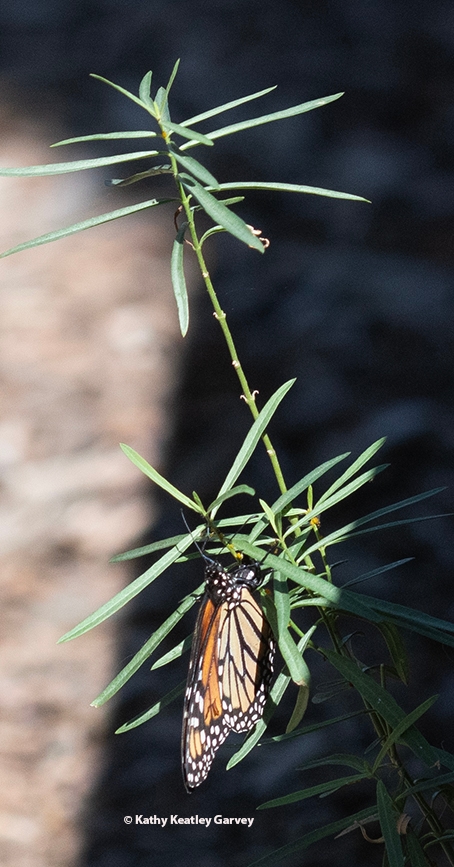
Where do Western monarchs go after leaving their overwintering sites along coastal California in February?
An observation: They didn't stop in the spring or summer to deposit eggs on any of our four species of milkweed in our Vacaville pollinator garden.
Spring? Zero. Zilch. Nada.
Summer? Zero. Zilch. Nada.
Fall? Yes.
Why not spring and summer? Did the monarchs passing through Vacaville opt for "a better habitat" in the cooler Pacific Northwest and beyond (British Columbia)?
"I wish I knew," commented UC Davis distinguished professor emeritus Art Shapiro, who has monitored the butterfly populations of Central California since 1972 and maintains a research website, Art's Butterfly World.
Beginning in September, as many five monarchs a day began fluttering into our garden. Some laid eggs.
To date, we've spotted some 20 eggs and caterpillars.
"This is generally consistent with the pattern we've seen in previous years," said UC Davis Department of Entomology and Nematology professor Louie Yang, who researches monarchs. "Even in Davis, we've been seeing more caterpillars in the late summer/fall. I think this is probably because some are stopping to lay eggs on the return migration, and the fall population is much larger than the spring migration population. Looking very carefully, we did also see eggs in the spring each year, but very few of them developed into large caterpillars." See the Louie Yang et al, research paper, "Different Factors Limit Early- and Late-Season Windows of Opportunity for Monarch Development," published in July 2022 in the journal, Evolution and Ecology.
The availability of food resources, such as tropical milkweed (Asclepias curassavica) that can overwinter in warmer climates, doesn't deter them from migrating, said UC Davis emeritus professor Hugh Dingle of the Department of Entomology and Nematology. Dingle, an internationally known expert on animal migration who has studied monarchs for more than two decades, said: "Migration and the diapause that accompanies it in the fall are determined by shortening photoperiod and temperature (warm temps can override short days hence the issue with climate change)."
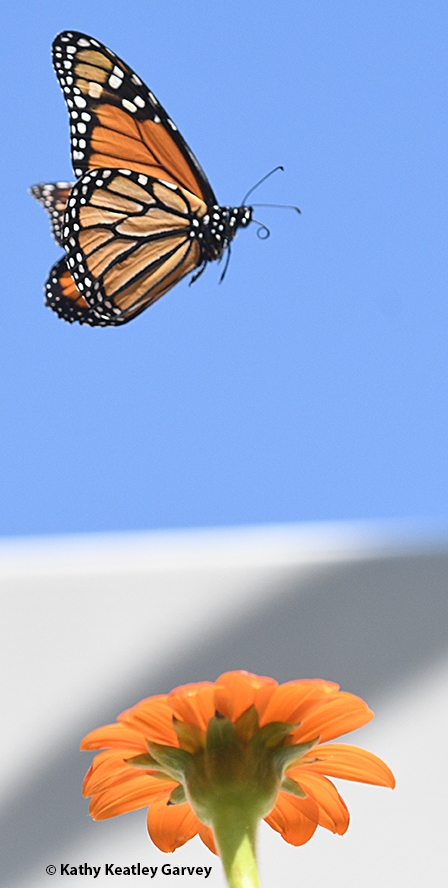
Said UC Davis professor Elizabeth Crone of the Department of Evolution and Ecology: "Monarchs may behave similarly in spring, but the spring population is probably much smaller than the fall one, so they are less likely to happen across your garden. Our estimate is that the population increases 2-3x each generation (so it's about 100-200x larger in Fall than Spring), then resets each year due to mortality during Fall migration and overwintering. There is some research from Sonia Altizer's lab in Georgia showing that monarch butterflies that encounter milkweeds during fall migration will leave reproductive diapause and breed. It is unknown whether these monarchs are effectively lost from the migratory population, or whether they or their offspring (the caterpillars in your yard) will continue on to the overwintering sites."
"The egg-laying females you are seeing now are likely migrants that have eschewed reproductive dormancy for reproduction," says entomologist David James, an associate professor at Washington State University who researches migratory monarchs. "This has probably always happened to some extent but is likely more significant now because of warmer falls."
"The lack of activity in summer in Vacaville was probably a function of most of the population having dispersed further east and north, maybe more than usual? They surely did pass through Vacaville in spring on their way north but clearly didn't stop to use your milkweeds. It does seem that some years they are more prone to frequent stopping/oviposition on their way north and east, yet in others they just keep flying. There's evidence that the latter was the case this year... with as many migrants making it to BC as to Washington... Normally they stop in Washington and only a handful make it to BC."
"The many mysteries of monarchs," James added.
James is the author of a newly published book, The Lives of Butterflies: A Natural History of Our Planet's Butterfly Life (Princeton University) with colleague David Lohman of the City College of New York. The book, released in the UK on Oct. 3, 2023, will be available in the United States starting Jan. 9, 2024.
Irish scientist Éanna Ní Lamhna recently interviewed the WSU entomologist in a podcast on RTÉ, or Raidió Teilifís Éireann. The book, she said, "showcases extraordinary diversity of world's butterflies, while exploring their life histories, behavior, conservation and other aspects of these most fascinating and beguiling insects." (See Bug Squad blog)
Listen to the butterfly podcast here: https://www.rte.ie/radio/radio1/clips/22294525/
Meanwhile, are you seeing fall breeding and egg-laying in your garden? We have for more than a decade, with some monarchs eclosing in November and December.
Attached Images:
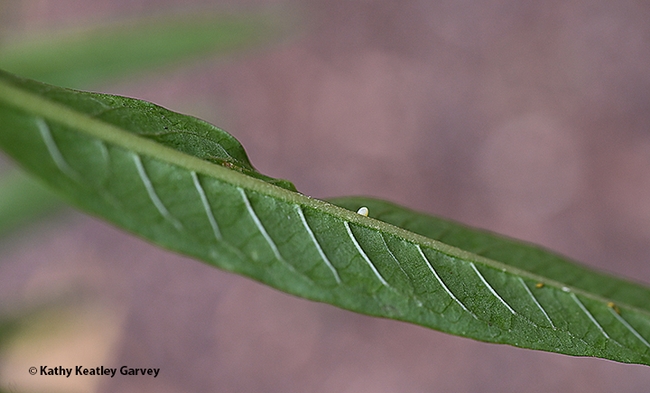
A tiny monarch egg. Image taken on Nov. 14, 2023 in a Vacaville garden. (Photo by Kathy Keatley Garvey)
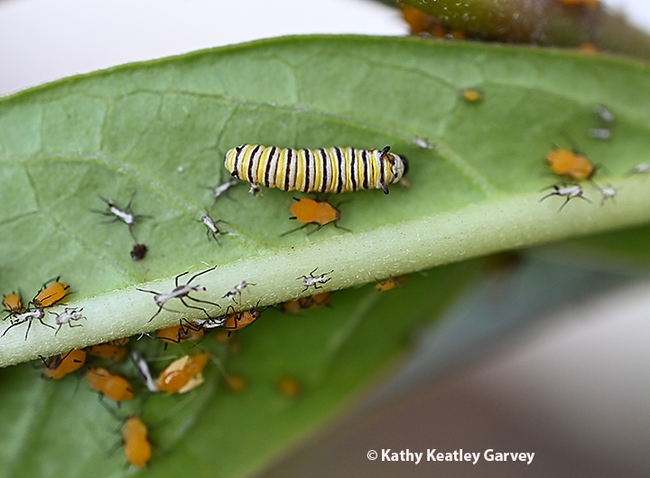
A monarch caterpillar sharing a milkweed leaf with aphids. This image was taken Nov. 15, 2023 in a Vacaville garden. (Photo by Kathy Keatley Garvey)
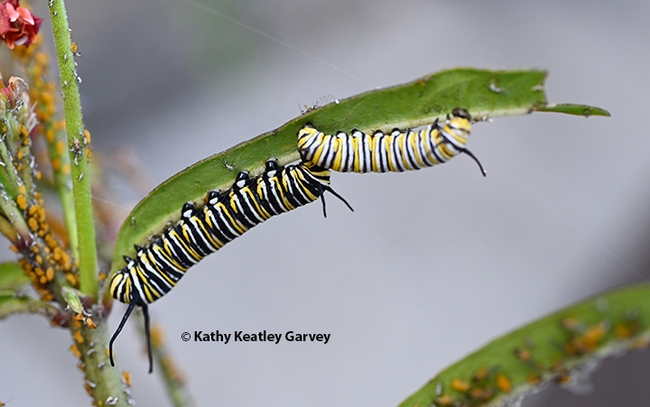
Two monarch caterpillars sharing a milkweed leaf. This image was taken Nov. 15, 2023 in a Vacaville garden. (Photo by Kathy Keatley Garvey)
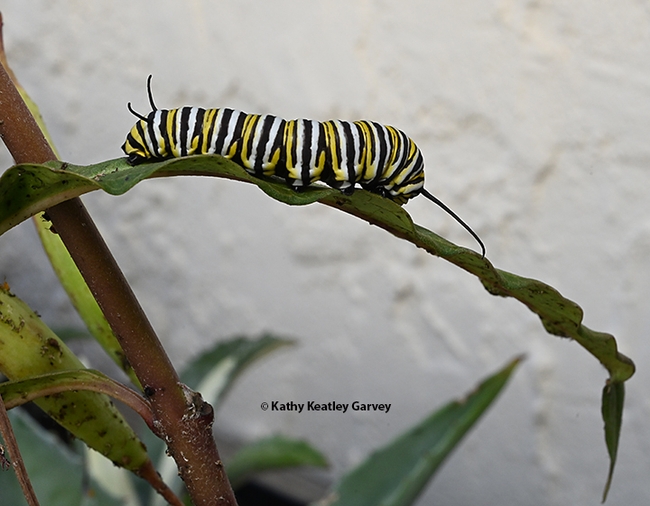
A very hungry monarch caterpillar on the move. This image was taken Nov. 18, 2023 in a Vacaville garden. (Photo by Kathy Keatley Garvey)
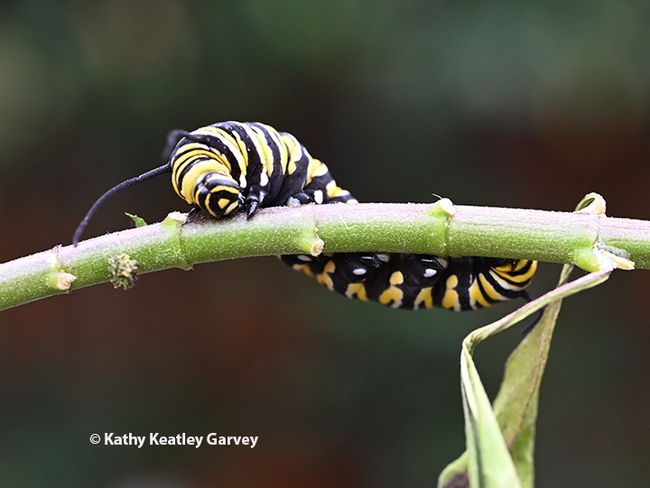
Hi, there! A monarch caterpillar faces the camera. This image was taken Nov. 14, 2023 in a Vacaville garden. (Photo by Kathy Keatley Garvey)